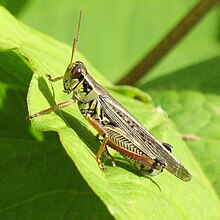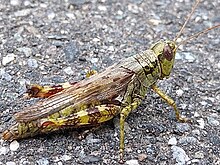Melanoplus femurrubrum
| Melanoplus femurrubrum | |
|---|---|

| |
| Bas-Saint-Laurent, Quebec | |

| |
| Charlestown, New Hampshire | |
| Scientific classification | |
| Domain: | Eukaryota |
| Kingdom: | Animalia |
| Phylum: | Arthropoda |
| Class: | Insecta |
| Order: | Orthoptera |
| Suborder: | Caelifera |
| Family: | Acrididae |
| Genus: | Melanoplus |
| Species: | M. femurrubrum
|
| Binomial name | |
| Melanoplus femurrubrum (De Geer, 1773)
| |
Melanoplus femurrubrum, the red-legged grasshopper, is a species of grasshopper belonging to the genus Melanoplus. It is one of the most common grasshoppers found in Mexico, the United States, and Canada.[1][2] This grasshopper is frequently used as a model organism in scientific studies, due to their abundance throughout North America and behavioral response to changes in climate.[3][4]
Identification
Melanoplus femurrubrum is a medium-sized grasshopper, in which males can range in length from 1.7 cm (0.67 in) – 2.4 cm (0.94 in), whereas females can range from 1.8 cm (0.71 in) – 3.0 cm (1.2 in) long.
Habitat
Melanoplus femurrubrum can be found in a variety of habitats found throughout most of North America, but prefer
Life cycle

Melanoplus femurrubrum, like other
Diet
Melanoplus femurrubrum is a mixed-feeding herbivore, which means they can consume a variety of shrubs, forbs, and grasses to meet nutritional needs.[2] This species dietary nutritional intake can vary depending on both abiotic and biotic factors. Consumption of plant macronutrient ratios of protein-carbohydrates fluctuate throughout the year to optimize available resources, and allows M. femurrubrum to compete with similar mix-feeding herbivores.[8] Slight increases in temperature can increase food consumption, digestive efficiency, and metabolic rate of M. femurrubrum, which results in increased growth rates.[4][9] In addition, M. femurrubrum will increase their plant carbohydrate intake and metabolic rate in the presence of predators, such as spiders.[10]
At high densities, M. femurrubrum can be considered a pest of gardens and agricultural crops.[2][5] This grasshopper can become a pest of grains, and includes soybeans, alfalfa, wheat, and barley, among others.[11] Melanoplus species eat grasses of all kinds, as well as leafy and grassy agricultural crops and garden plants. They feed on the leaves, and sometimes fruit, flowers, and buds, as well as tree bark.
Latitude and body size
At higher latitudes, the body size of Melanoplus femurrubrum decreases. In the colder region, there is a shorter growing season, which requires individuals to reach maturity at smaller sizes and develop faster so that they can reach the reproductive stage in one season. Melanoplus femurrubrum has more time to complete the development stage at larger body size in warmer sites.[12]
Research
M. femurrubrum was irradiated with an acute dose of X-rays during individual stages of meiosis, and chiasma frequency was measured.[13] Irradiation during the leptotene-zygotene stages of meiosis (that is, prior to the pachytene period in which crossover recombination occurs) caused an increase in subsequent chiasma frequency. These results imply that X-irradiation induces DNA damages that are repaired during meiosis by a pathway leading to formation of chiasma.
References
- ^ Red-legged grasshopper, USDA
- ^ ISBN 0-8014-8948-2.
- ^ PMID 19769112.
- ^ S2CID 17145785.
- ^ a b "Species Melanoplus femurrubrum - Red-legged Grasshopper". BugGuide. Retrieved 23 April 2017.
- .
- .
- PMID 18238894.
- PMID 27870021.
- PMID 20713698.
- ^ "Red-Legged Grasshopper Insect Information". www.insectidentification.org. Retrieved 2016-01-07.
- S2CID 17145785.
- PMID 5797806.
External links
- Red-legged Grasshopper, BugGuide
- Orthoptera, Ojibway Nature Centre
- Red-legged Grasshopper Alberta
 Data related to Melanoplus femurrubrum at Wikispecies
Data related to Melanoplus femurrubrum at Wikispecies Media related to Melanoplus femurrubrum at Wikimedia Commons
Media related to Melanoplus femurrubrum at Wikimedia Commons
